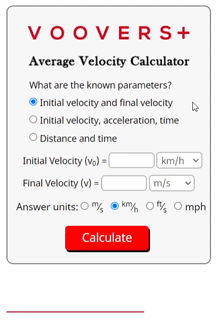Related Content
Average Velocity Calculator


To get unlimited answers, .

Lesson on Average Velocity
Lesson Contents
What is Velocity?
In the physics discipline of classical mechanics, we study the motion of objects. A very important descriptor of an object’s motion is its velocity. The velocity of an object is how quickly it changes position with respect to time in a given direction.
Velocity is considered to be a vector quantity because it has a magnitude (rate of change of position with respect to time) and a direction (direction of travel). Therefore, if either the magnitude or direction changes, the velocity has changed.
How to Hand Calculate the Average Velocity
How we calculate average velocity depends on which parameters are known and what our frame of reference for the object’s motion is. The known parameters will restrict the frame of references that we may choose.
For example, we may only know the distance traveled and how long it took the object to travel that distance. We may calculate the average velocity through that traveled distance by using the formula:
vaverage = d⁄t
Where d is distance and t is time.
However, we can calculate a car’s average velocity irrespective of time and distance if we know its initial velocity, final velocity, and that it was under constant acceleration. For this, we may calculate the average velocity by using the formula:
vaverage = (v0 + v)⁄2
Where v0 is the initial velocity and v is the final velocity.
Another common average velocity scenario is with a known initial velocity, acceleration, and time under acceleration. To solve for the average velocity of this object, we may use the formula:
vaverage = (2v0 + at)⁄2
Where v0 is the initial velocity, a is the acceleration, and t is the time under acceleration.
How the Calculator Works
This calculator is written entirely in plain JavaScript (JS) and runs in your device’s internet browser JS engine, allowing for near-instant solutions and extremely responsive functionality.
First, the calculator detects your selected problem type and all selected units. It then converts all applicable values to SI units. Those values are then plugged into the applicable formula based on your problem type, and out comes the raw answer.
The raw answer is then converted to your selected output unit if needed. If there is a decimal in the answer, it is rounded to the fifth decimal place. The final number is then displayed in the answer area of the calculator.


